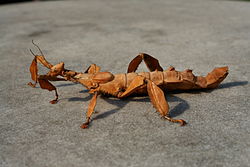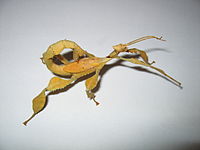- Extatosoma tiaratum
-
Exatostoma tiaratum E. tiaratum Scientific classification Kingdom: Animalia Phylum: Arthropoda Class: Insecta Order: Phasmatodea Family: Phasmatidae Subfamily: Extatosomatinae Genus: Extatosoma Species: E. tiaratum Binomial name Extatosoma tiaratum
(Macleay, 1826)Extatosoma tiaratum (common names Giant Prickly Stick Insect[1], Macleay's Spectre[2]) is a large species of stick insect endemic to Australia.[3][4] The species has the Phasmid Study Group number PSG9.
Contents
Range
E. tiaratum is native to Queensland and New South Wales but has extralimital distribution as far away as New Guinea.[2]
Description
Female adult E. tiaratum are covered with thorn-like spikes for defense and camouflage. Their long, rounded bodies grow to about 8 inches (20 cm) long.[3][4] The females are further described as "heavy-bodied, brachypterous and (having) numerous spines and integumental expansions on the body and legs, including a tuft of spines on the conical occiput of the hypognathous head".[5] As mentioned, the wings of the female are too small for flying, especially when she is gravid.[1]
Exhibiting the sexual dimorphism of many similar insects (particularly other phasmids as well as mantises), males are small and thinner, growing only about 11 cm in length and have three ocelli. Males lack the thorny growths except for spikes around their heads. They have long wings and are good flyers who readily take to the air if disturbed or in search of females.[3][6]
Both genders, when threatened, stand on the front and middle legs, pointing their abdomen up or to the side in a sort of "scorpion" pose. They fold back their legs to defend themselves if anything comes in contact with their abdomen.[3] Adult males can release a defensive odor that humans might not find offensive as it "is rather reminiscent of peanut butter or toffee".[1]
E. tiaratum also take a curved pose when it hangs inverted amongst foliage with "its highly procryptic abdomen curled over its back."[2] Like many stick insects, E. tiaratum sway back and forth or side to side when disturbed. They also move this way to blend with foliage rustling in the wind.[1] Individual E. tiaratum vary in color and appear brown, mottled brown, dun, green, a reddish color, a cream color, a yellowish color, and even entirely white.[2][5]
Reproduction
E. tiaratum typically reproduce through sexual reproduction and produce eggs that hatch four months later. When no males are present in the population, this stick insect exhibits parthenogenesis instead. Eggs laid without fertilization take up to nine months to hatch and produce only females. In either cases, the female "flicks" her eggs, swinging her tail, up to several feet to land on the forest floor. These eggs must be kept relatively cool - under 25°C - or they are unlikely to hatch.[2][3]
The outside material of E. tiaratum eggs consists of lipids and other organic compounds that ants identify as food. They carry these eggs to their colony, consume the edible outer portion, and dump the intact eggs into their waste piles. Luckily for captive breeding, the ants eating the edible outer layer is not crucial to development, so they will hatch just as healthy without the need for any removal of the outer layer, which is not easily visible.[3][5]
Newly-hatched E. tiaratum nymphs are ant mimics and resemble the insects in whose nest they are born. Their aposematic pattern—orange head, white collar, the rest black—mimics the ant genus Leptomyrmex and makes them appear toxic. Although most adult stick insects are notoriously slow, these nymphs are speedy, active, and quickly make their way to the trees. Their locomotion slows when they moult into their second and subsequent instars. Female acquire their distinctive spiky appearance through additional moults as well.[3][5][1]
Cultivation
This species is relatively common in captivity. It is used in laboratories, kept as project in schools (as is Carausius morosus[1]), and is popular pet among breeders of exotic insects in North America and Europe. One breeder advises specifically "For a stick insect with body length 127mm, to keep 2 adult females, you need a cage at least 600mm high, 300mm deep and 300mm wide."[2]
Although the gestation period of their eggs is several months long, they are prolific breeders. A breeder notes that because of this insect's habit of flicking its eggs, one can "hear them clicking against the glass" of their terarria.[2] Some breeders in the United Kingdom, concerned with the negative effects of inbreeding on the vitality of their stock, have introduced new genes from abroad.[1]
Diet
E. tiaratum are vegetarians and breeders recommend feeding them bayberry, bramble, eucalyptus (their natural food in their native Australia), hawthorn, oak, photinia, raspberry, rose, and salmon berry (red or yellow).[3][2] One source reports good results from feeding these insects California Wax Myrtle (Myrica californica) as the sole food plant.[2]
See also
- Extatosoma bufonium, a similar species[2]
References
- ^ a b c d e f g [1] Extatosoma tiaratum tiaratum* (Macleay, 1827), "Macleay's Spectre/ Giant Prickly Stick Insect"
- ^ a b c d e f g h i j [2] A guide to the stick insects of Australia
- ^ a b c d e f g h [3] PhasmidsinCyberspace.com 2005
- ^ a b [4] Giant Prickly Stick Insect (terrariet.dk)
- ^ a b c d [5] Key, K.H.L. (1991). Phasmatodea (Stick-insects). pp. 394-404 in CSIRO (ed.) The Insects of Australia. A textbook for students and research workers. Melbourne: Melbourne University Press, Vol. 1, 2nd Edn.
- ^ [6] Rentz, D.C.F (1996). Grasshopper Country, Chapter 16, Phasmatodea: Leaf and Stick Insects, pp. 244-257
External links
Categories:- Phasmatodea
- Insects of Australia
Wikimedia Foundation. 2010.




